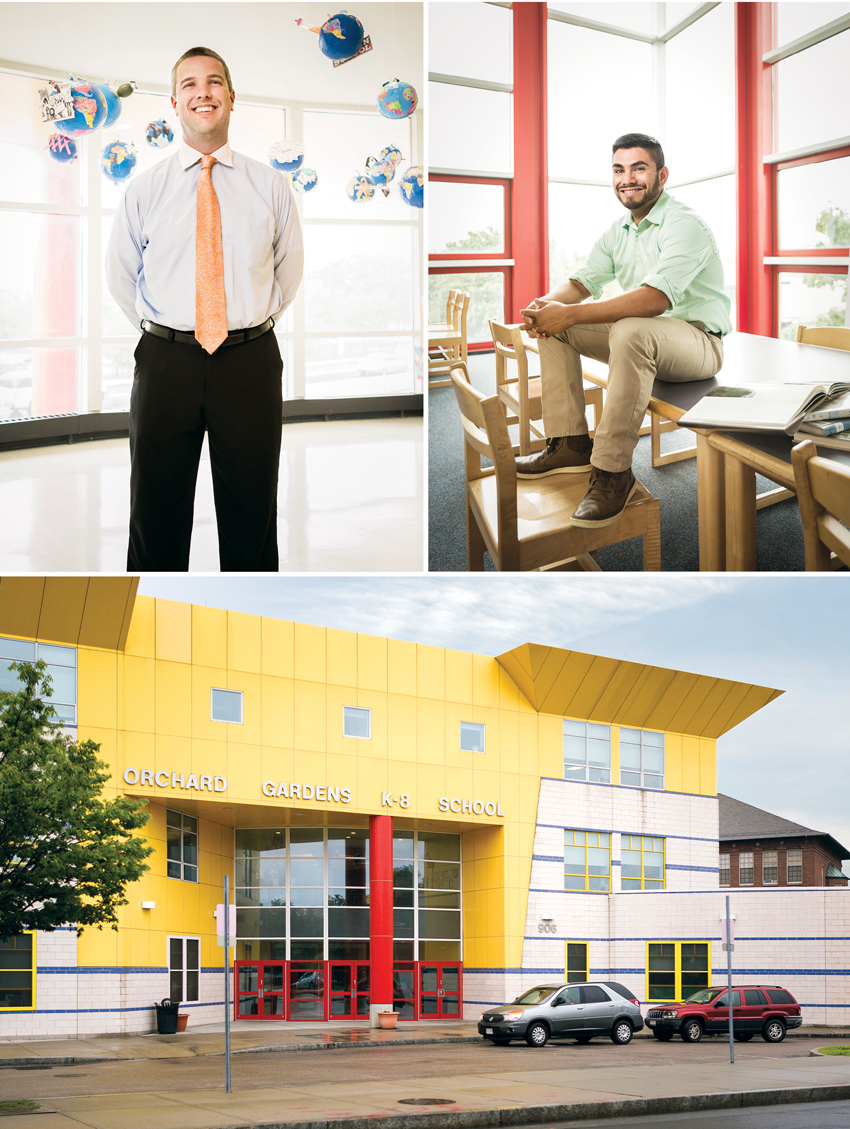A Tale of Two Boston Schools: Orchard Gardens and Higginson/Lewis

At Orchard Gardens, principal Andrew Bott (left) and teacher Andrew Vega (right) are part of a team leading the city’s most dramatic academic turnaround. / Photograph by Trent Bell
A WEEK LATER, over at Orchard Gardens, Andrew Vega’s eighth-grade English class was trying to puzzle its way through the first chapter of Tim O’Brien’s classic Vietnam War novel, The Things They Carried. Sitting in a bright, airy classroom with a view of the Prudential Center, the students talked about how the soldiers deal with the reality that they could die at any moment. One boy raised his hand. “Why isn’t it, like, dialogue?” he asked, referring to the absence of quotation marks at this point in the book.
“It is dialogue,” Vega responded, “but it’s missing quotes.”
“Why?” a girl asked.
“This is a high-school-level question,” Vega responded. “Let’s pretend this was a reading assignment the night before. Now your teacher walks up to the front of the room. ‘Good morning, class. Let’s talk about chapter one. Antonio, why are there no quotes in the dialogue?’”
Vega’s class erupted in protest.
“Let me tell you a secret, okay?” Vega lowered his voice. “In English, it’s all made up.”
“That’s not true!” someone called.
Vega continued calmly: “If you come to class and have an idea and you can support it with something you’ve read, you can turn that into something. If you continue to look for ‘the right answer’ when you talk about books at the high school level, you’re never going to do well. You have to take risks.”
Orchard Gardens sits near a housing project of the same name, and before it became a turnaround school, it was among the worst-performing schools in the state, beset by high staff turnover, a revolving door of principals, an incoherent curriculum, and kids who were out of control. “It was chaotic,” says Sarah White Smith, the middle school guidance counselor, who started there before the turnaround.
It is anything but chaotic now. The student body hasn’t changed—the portion of students who come from families in poverty is 87 percent, compared with 88 percent at the Higginson/Lewis. But today, its MCAS scores are among the fastest-rising of any school in the district. It has become Boston’s flashing-neon rebuke to the idea that ineffective public schools filled with poor kids from often-troubled families cannot be fixed.
The best-known aspect of Orchard Gardens’ refashioning was the controversial decision by its principal, Andrew Bott, to replace 80 percent of its staff when he took over the school in 2010, even though the state’s school-reform law required him to replace only 50 percent. It wasn’t so much that Bott, who is white, wanted to start with a clean slate. He wanted people around him who were convinced that, with creativity and determination, they could succeed. Early on, he says, he was talking with the staff about what it would take to transform the school with the same student population it had always had when a teacher spoke up. “You just don’t get it! You don’t understand these kids, and you don’t get this neighborhood,” she told him angrily. “It struck me,” Bott says, “that if that’s the mindset, then the students you’re teaching will never achieve. I needed to know that as a staff we would not come in with any judgments, any preconceived notions about our students and the ability to transform what had been in many ways utter dysfunction.”
Bott recruited veteran BPS teachers he knew from other schools, but also handpicked young, energetic, and demanding teachers like Vega, who left a public high school in Los Angeles to teach at Orchard Gardens. And that was just the starting point. Bott and his teachers had much greater autonomy than ordinary public schools to shape the school day and design the curriculum. Each of Boston’s 12 turnaround schools was given additional federal money for three years, and was allowed to add an hour to the typical BPS school day. Using their extra $1.3 million a year, Bott and his staff added a voluntary afterschool program for the elementary schoolers and a mandatory three hours of afterschool programming for the middle schoolers. One of Bott’s more-striking moves was to replace the school’s security personnel with visual-arts, dance, music, and theater teachers.
In many of Boston’s regular public schools, including the Higginson/Lewis, teachers get less than an hour per week to meet together to discuss students who are struggling, collaborate on joint projects, or brainstorm solutions to challenges that arise at the school. At Orchard Gardens, elementary teachers spend three hours a week, while middle school teachers get four. They’re guided by colleagues who, thanks to the federal money, have spent a lot of time over the past three years learning to be “teacher leaders.”
The school is full of high expectations, and Bott has made it a habit to hang posters around the building that underline the point. After the first graders’ trip to the White House in 2012, he blew up a photo of President Obama, his eyebrow cocked and a slight “That’s impressive!” smile on his face as he stands watching a row of Orchard Gardens kids. Underneath, Bott put, “Look how impressed the President is with OG. Would he have been impressed by you today?”
“Kids realize when they’ve been counted out,” says Meghan Welch, the school’s director of operations. “They get when they’ve been marginalized. They get when, eh, no one really cares. But that doesn’t mean they’re not excited to seize opportunities when they come.”


